
Man's best friend plays a vital role in the war against poaching

Earlier this year, I had the privilege of meeting some of the Kruger National Park’s anti-poaching team, and I fell in love with one of them. Muscular and strong, he embodied everything you would come to expect in this line of work. A fierce protector, he also had a heartbreakingly vulnerable side. He cowered when faced with the inevitable shouting and shooting that comes with successfully tracking down a poacher; visibly upset. He required affirmation at this moment, some acknowledgement for a job well done. Because this lovable ranger had been trained a little differently and, as a four-legged, waggy-tailed member of the canine team, he stole my heart.
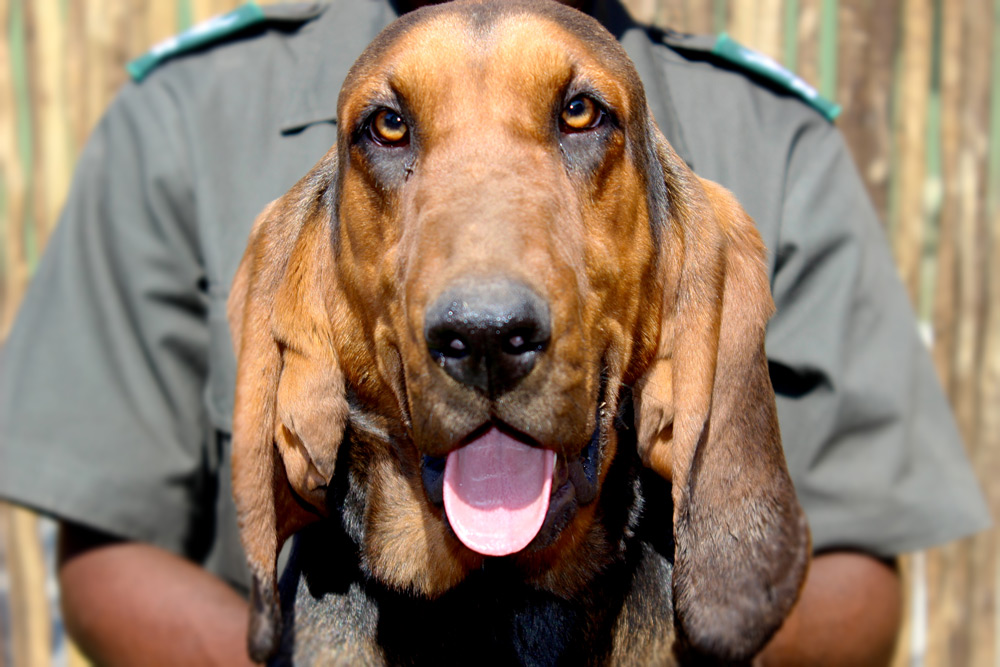
A history of canines in conservation
Man has trained dogs to help with work for generations. From security hounds and police force canines to hunting dogs, herding dogs and Anatolian shepherds that work to protect domestic livestock from predators, dogs are not only man’s best friend but have proven themselves to be some of our most valued employees and colleagues.
When it comes to anti-poaching, canine units are now all the rage, but this wasn’t always the case. Eric Ichikowitz, Director of the Ichikowitz Family Foundation, whose initiatives include the establishment of one of the most substantial anti-poaching skills and canine training academies in Africa, explains: “The first canine was introduced to Kruger National Park in December 2010 to help fight poaching. At the time, the use of canines in a Big Five game environment was met with a lot of resistance, and most commentators were of the view that canines were not suited for an anti-poaching role when faced with the Big Five.”
When the PAMS Foundation in Tanzania first started talking about the amazing abilities of tracking and detection dogs, little was known about working with dogs in Africa, and law enforcement and conservation officials were sceptical. But after seeing them in action, many a raised brow turned into a crinkled one as people began to formulate plans to establish anti-poaching canine units, and criminals who observed them in action soon started to fear them.
Kruger now has over 50 working dogs spread throughout the park
After the success of Ngwenya, the first dog to be introduced into the Kruger National Park, everyone began to see the impact that properly trained dogs and handlers could have in anti-poaching teams. Says Ichikowitz: “These days, almost all big reserves have a canine unit assisting their anti-poaching units. Since the launch of Paramount Group’s Anti-Poaching and K9 Academy, we have seen a rise in national parks – not just in South Africa but in many African countries – and private reserves that are establishing canine units in their parks.” For instance, Kruger now has over 50 working dogs spread throughout the park under the guidance of the dedicated and passionate Johan de Beer, who has been instrumental in setting up the canine centre in Kruger for the continued management of this programme.
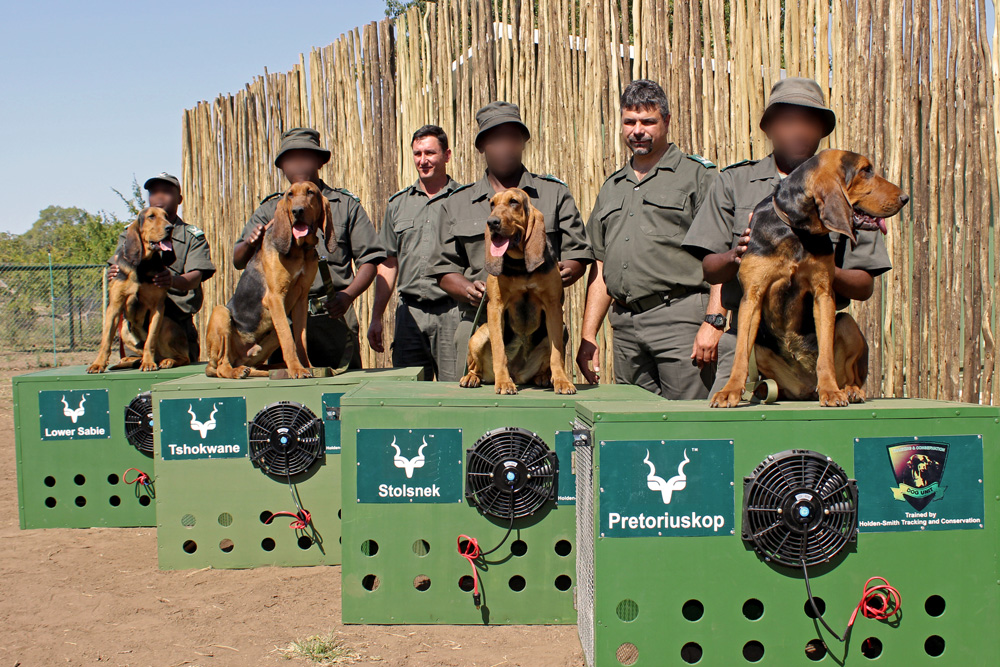


Types of dogs
While it would be wonderful to adopt every single rescue dog and turn them into anti-poaching pooches, the reality is that these dogs need to be selectively bred for efficiency in their specific line of work. As Kirsty Brebner, Rhino Project Manager at the Endangered Wildlife Trust (EWT), puts it: “You wouldn’t use a dachshund to cover long distances at speed – it just doesn’t have the legs. Breeds of choice are generally shepherds (Belgian and German), but other breeds include border collies, labradors, springer spaniels, beagles, bloodhounds and bloodhound crosses. Working Dogs for Conservation (WD4C) works successfully with shelters, but it is difficult – it takes assessing a lot of dogs to find the right dog with drive.”
For instance, in the Detection Dog Programme, supported by PAMS Foundation, which falls under the Tanzanian Police Horse and Dog Unit, there are nine dogs in the team. Five of these are a mixed-breed of local Tanzanian dog with some German shepherd. These dogs are more resistant to disease than foreign dogs and are better adapted to the local climate. And at Big Life Foundation in Kenya, they typically work with two breeds – bloodhounds and shepherds.
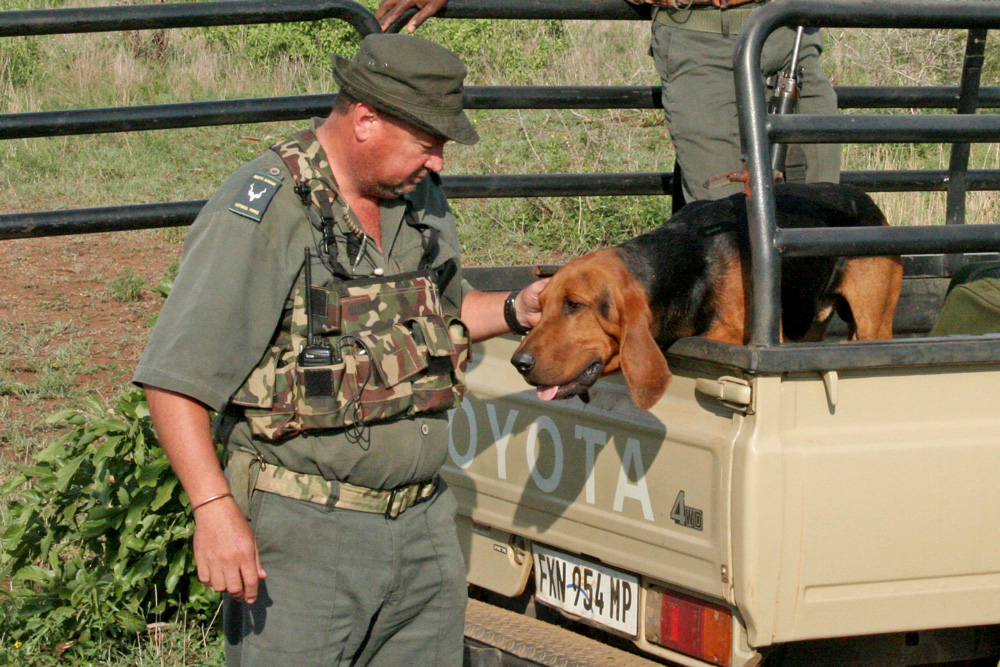
However, there is a mixed breed rescue dog, called Didi, who is an exception to the rule. Jeremy Goss of Big Life Foundation explains: “She was selected because she certainly has some German shepherd in her, but that’s about all we know. Thanks to her diverse genetic background, Didi has turned out to be remarkably resilient to local diseases, and this makes up for her relative lack of scent receptors.”
When it comes to dogs with a strong sense of smell, you can’t go wrong with a hound. Foxhounds, blue ticks, and bloodhounds are all instinctively tracking dogs and can follow older tracks under challenging circumstances. It is said that one dog, together with its handler, can cover 60 times the area that a ranger without a dog could. Hounds also have great stamina and can handle extreme temperatures better than other breeds.
In Kruger, the latest additions of four bloodhound-doberman crosses have been a great success. One particular dog, Kilalo, even surprised her handler on a recent practice patrol when she led him on what he initially believed to be an incorrect detour after he lost sight of a poacher’s footprints. However, the dog was indeed still following her nose and managed to cut out a large section of track by taking a nifty shortcut. Together, Kilalo and her handler have already led to 18 successful poacher arrests in Kruger.
The rest of Kruger’s canine unit consists of a mix of bloodhounds, malinois and shepherds, with each dog playing a unique role. Specialised tracker dogs can follow spoor for up to two to three days; search dogs are used to detect species items such as rhino horn and ivory, or sniff out arms and ammunition at roadblocks, park gates, crime scenes or at suspect’s houses; and assault dogs are trained to attack and detain poachers.
Conraad de Rosner, founder and director for K9 Conservation, is well known for his work with weimaraners and Belgian malinois. Weimeraners are used to track animals, detect animal remains and snares, locate wounded animals and occasionally assist wildlife vets and scientists with their work. His malinois, on the other hand, are used for tracking human suspects, detecting firearms and bullet casings, and performing restraining functions when detaining suspects requires force. Rosner says: “While both breeds are classed as ‘patrol dogs’, their functions differ somewhat and often their skills and abilities complement and assist each other in the field. For this reason, and depending upon the situation, two field rangers – each with a different dog breed – are sometimes deployed together. All our dogs are trained in protection work, and they are capable of suspect apprehension should the need arise. These dogs are specially trained to bite or apprehend a suspect only upon command, and to detain that suspect with minimal force.”
With so many personalities around, it’s challenging to pick a favourite pooch. That said, van Straaten’s favourite breed is the Belgium malinois. The reason, he explains, “is that it’s a good all-rounder. It can track, apprehend a poacher, protect the handler, and search for evidence and illegal substances.” However, he does say that every dog he has worked with has a special place in his heart – they are all individuals.



Trials and tribulations
It has not always been easy trying to convince rangers and anti-poaching teams, which have more than enough on their plate and limited access to funds, that dogs are a good idea. And, as the use of canines in conservation work progresses, new issues arise that need to be worked into budgets and training programmes.
For instance, dogs are initially often trained with rewards. Now, imagine a dog that has completed a job well done, suddenly to be faced with a situation in which the handler is in a combat zone, complete with gunshots, shouting and confusion. This is not the reaction the dog necessarily expected, and it can become frightened. Krissie Clark of PAMS Foundation explains: “Dog handlers have had to learn new skills and have to carry around dog treats and toys to reward the dogs when they detect the correct scent. One challenge is to keep the dogs productive and motivated, as they need to be finding the right scent regularly so they can be rewarded. Thus, operations need to be increasingly based on good intelligence to avoid doggy burnout (dogs sniffing for days on end without finding anything, resulting in limited rewards and playtime for the dogs).”
Handlers also need to know how to react if a dog gets injured in the bush, or how to keep their dogs fit if they can’t work for a couple of days or weeks for any reason. Sniffer dogs also don’t necessarily come across the contraband they are trained to sniff every day, such as rhino horn and ivory. Thus the dogs and their handlers need constant refresher courses to tackle these issues, often with trained professionals and specialised veterinarians, which can be challenging to arrange.
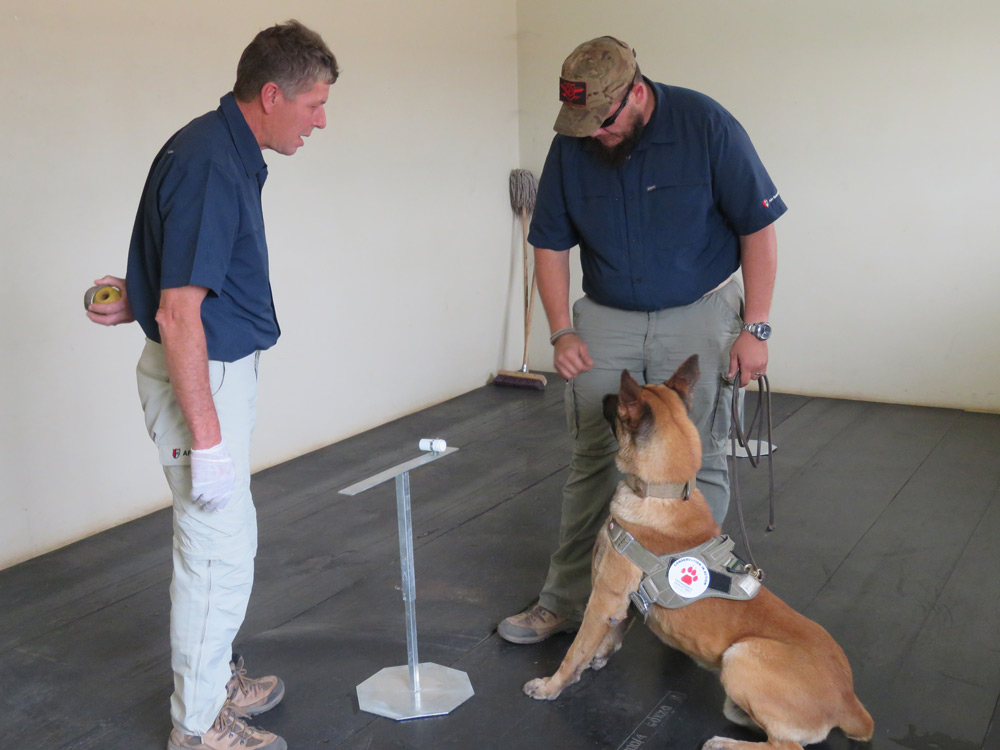

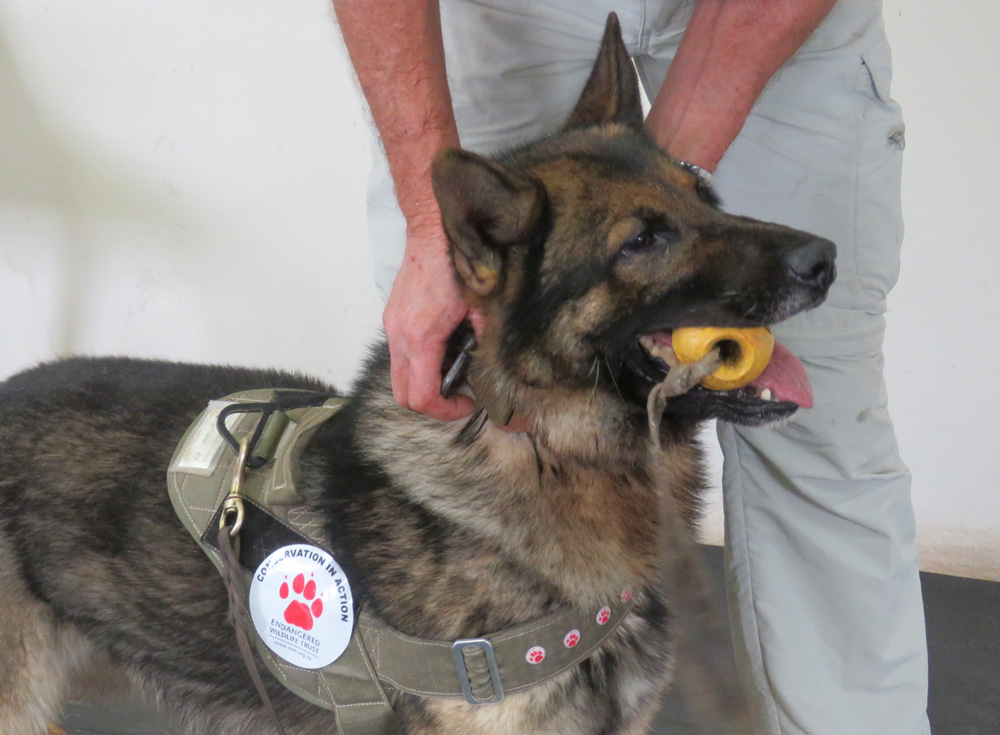
Dogs themselves also need to be protected. They work in daytime temperatures that can often reach over 40ºC on challenging terrain, with several threats to their lives. De Rosner explains: “The challenge is, of course, being on a Big Five game reserve and the dangers that come with mostly walking on foot. The heat of the day also limits the working hours of the dog. The kit and equipment used for a working dog are crucial. It must be comfortable for the dog and easy to use for the handler. For instance, there are now companies that are testing lightweight but effective bulletproof vests for canines, which have a specialised gel that can regulate the dog’s body heat. So they keep it warm when it is colder or cool it down during hot temperatures.”
Also, specialised goggles to protect dog’s eyes, booties to prevent cuts and lacerations on their feet, compactable water bowls, air-conditioned portable kennels, and high-tech electric fences to keep predators out, are now all things seen on wishlists of game reserves across Africa. A handler no longer carries only a gun and a radio, but also a canine first aid kit and a ball for his trusty sidekick. Krissie Clark of PAMS Foundation elaborates: “As with any domestic animal, the detection dogs are susceptible to disease and heat. In Tanzania, if the dogs are working in the bush, trypanosoma (sleeping sickness), which is transmitted through tsetse fly bites, can kill them if not detected and treated early. There are also many other parasites to which the dogs may be susceptible. Good quality food and regular check-ups with the veterinarian are essential for healthy, happy dogs.”
Goss echoes these sentiments: “The African bush is a challenging environment – often hot, dry and dusty. The dust, in particular, has been a challenge for the bloodhounds due to the rolls of skin that they have, and our dogs were contracting frequent eye infections. They have now had operations to remove some of the excess skin around their eyes, which will hopefully solve the problem. There is only so much equipment that is useful when working with tracker dogs – the most important skill is a timeless one, and that is the handler’s understanding of the abilities (and limits) of their animals.”
It does indeed seem to be that the biggest challenge of all is selecting the best handler for each dog. But while it may be the greatest challenge to pair dog and handler, it also may be the greatest reward. Clark says: “It has been heartwarming to see how the relationships between the handlers and their specific dogs have developed so rapidly to the point that they have truly fallen in love with their dogs and care for them as if they are their own children. Developing such close bonds with dogs is so special.”
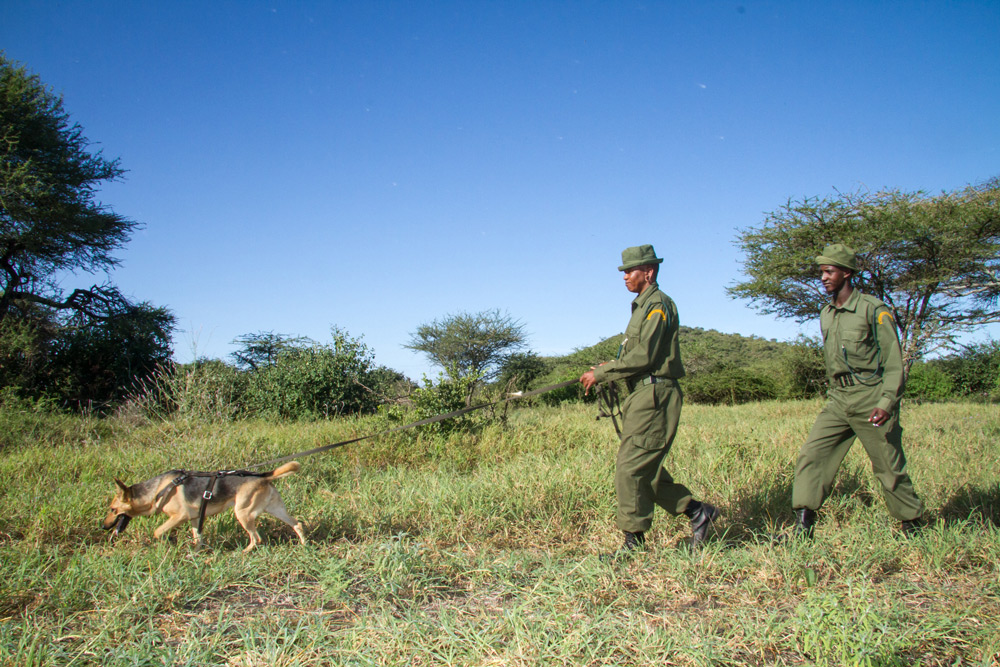

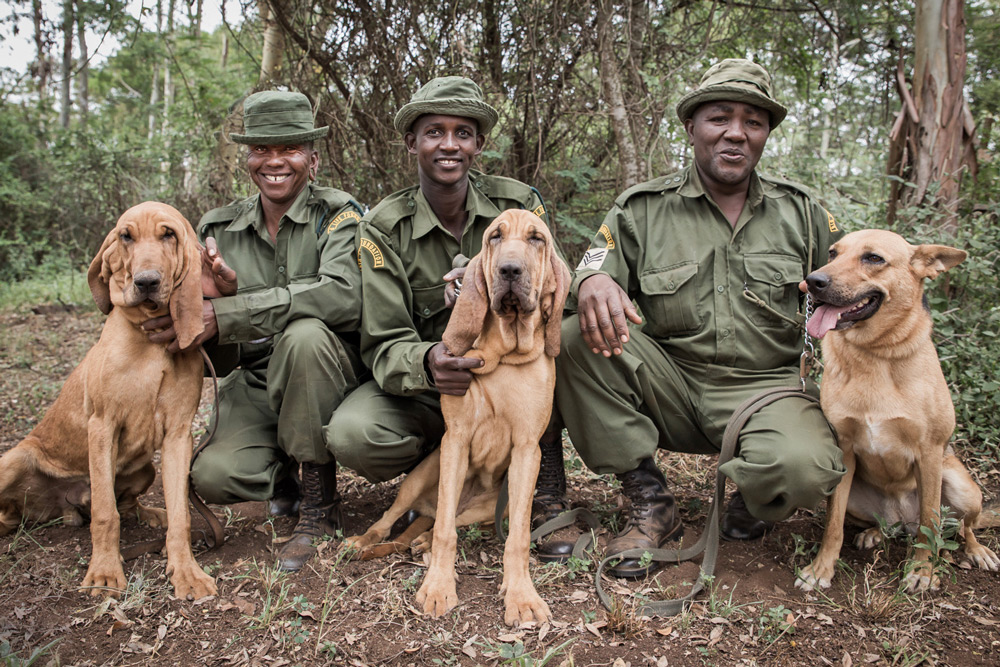
Notable achievements
Some of these canine units have become so successful that their operations have led to a significant decrease in poaching. De Rosner can proudly boast about one particular reserve, with an anti-poaching unit supplied by K9 Conservation, that saw the addition of 18 black rhinos two years ago. To date, all the rhinos are alive and well, and a few of the females are even pregnant. Goss echoes a similar sentiment: “When Big Life Foundation started using dogs in 2010, poaching (and particularly elephant poaching) was still a major threat in the Amboseli ecosystem. At that time, the dogs were responsible for tracking down poachers, with such success that they can certainly be identified as a factor in the huge reduction in poaching in Amboseli. But the dogs are now more important as a deterrent, as poachers know that it is highly risky to poach in these areas.”
Goss uses one particular incident to explain just how effective the dogs can be. This time it was Didi that was involved in tracking elephant poachers from a scene in Tsavo West National Park. “It started the same way that all elephant poaching incidents do – the grisly discovery of lifeless bodies, five of them in this case, lying in the bush with their faces hacked off — a family group of all ages. The Kenya Wildlife Service tracker dog was straight on the poachers’ trail. The Big Life tracker dog, Didi, and rapid response units joined the hunt where the tracks left the Tsavo West National Park, moving onto community land. The tracks ran, and the rangers ran with them. Assisted at times by expert human trackers, the dogs led the rangers to two neighbouring homes. There was no sign of the ivory, but Didi led the search to a home that contained two axes and a saw, still wet with blood. With the help of the local community, two suspects were identified and arrested. Big Life activated its informer network and, a day later, word came back on a third member of the gang, hiding out in a small town some 40 miles from where the elephants were killed. An undercover Big Life team went in that evening, and together with a back-up unit, arrested the third suspect at 4 am the next morning.”
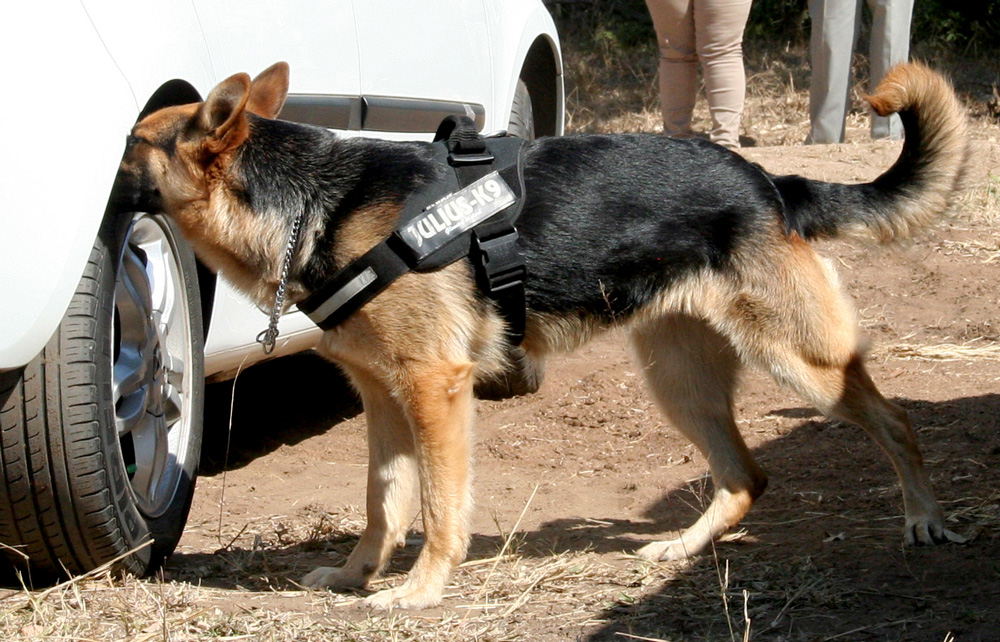
And when it comes to arrests, the dogs are proving to play a vital role. Notable achievements include the detection of ivory in several critical cases in Tanzania involving notorious Chinese poaching syndicates. And in South Africa, according to a recent statement from SANParks, “over the past ten months, the canine units have successfully tracked and taken down over 90% of the poachers arrested in the Kruger National Park.”
Ichikowitz says: “The most notable achievement is Killer, a Belgian malinois that was trained by us and that is deployed in Kruger National Park as part of their anti-poaching unit. Killer and his handler have been responsible for the arrest of 115 groups of poachers in Kruger. Killer received a gold medal from Prince Harry for his contribution to conservation.” While another of the Paramount Group’s pooches, Arrow, made history earlier this year when he became Africa’s first skydiving anti-poaching dog, truly taking conservation efforts to new heights.
Another particularly special canine is Duma, a German shepherd puppy at the Fundimvelo Thula Thula Rhino Orphanage. He plays the role of protector and playmate for orphaned rhinos and will go and get the carers if a rhino is calling or awake. The team at the orphanage are also trying to train him to detect orphaned rhino calves in the bush.
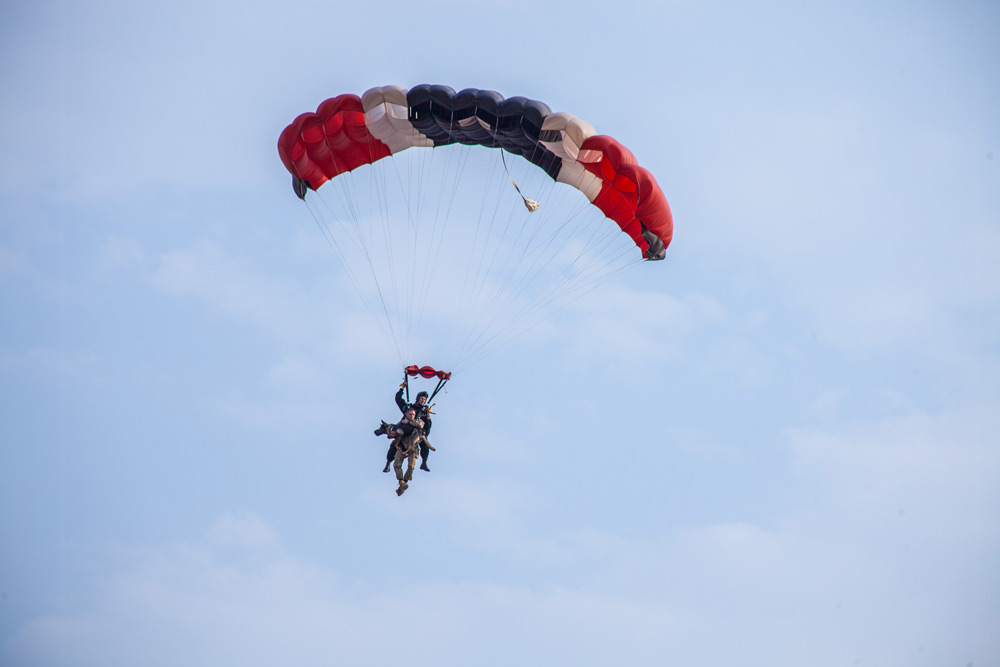
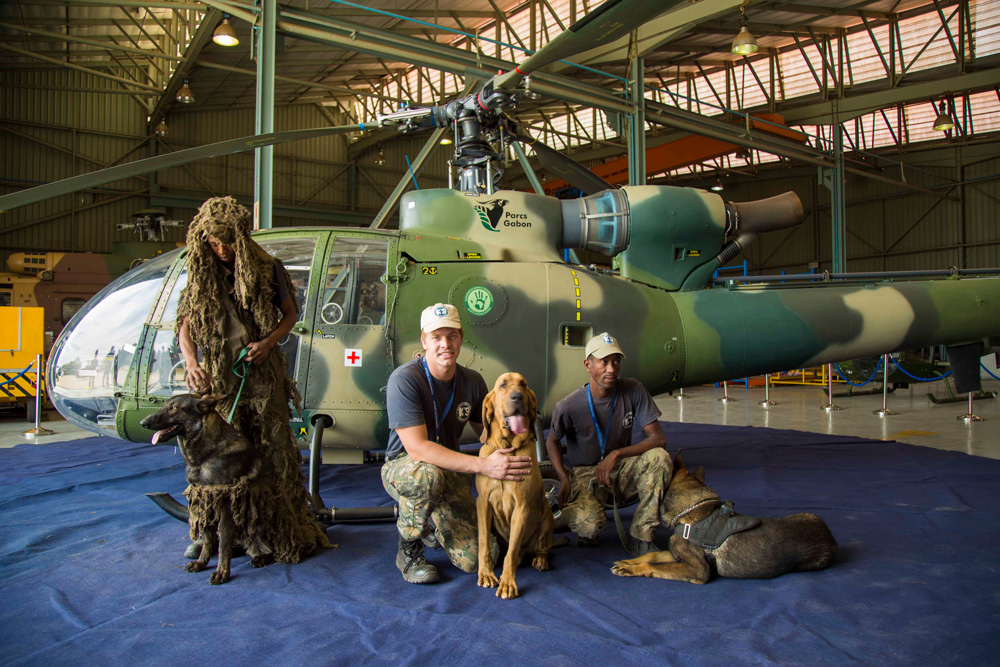
What the future looks like
A positive message of success consistently comes from the people involved with canine anti-poaching units. In the words of Kirsty Brebner, Rhino Project Manager at EWT: “Conservation dogs are playing an increasingly important role in tackling the scourge of wildlife crime – these animals are often the unsung heroes in this battle.”
The future looks promising but, according to Brebner, “increased and more dangerous contact with poachers, as well as smarter ways of smuggling contraband, need changes in training methods. The most valuable thing I think is networking and the sharing of successes and failures. I think that this is critical going forward – that we encourage dog programmes to talk to each other, share, and even have rangers from new projects spend time with seasoned rangers.”
Van Straaten also emphasises that, as poaching activities become more complex, so anti-poaching methods need to adapt. “New projects are on the way where dogs are going to be trained to detect poison and gunshots to take the handler to the crime scene where the shots are being fired. These skills add value to the dogs and will make the dog teams much more functional and efficient.”
Other projects include the use of canines at more points along the supply chains of illegal wildlife products, including international shipping and aircraft ports, a coordination between on-the-ground canine units and drone technology, and even a coordinated project between the National Parks Agency of Gabon and the Ichikowitz Family Foundation, to introduce an anti-poaching canine team to protect Gabon’s forest elephants.
De Beer sums it all up, succinctly: “I do think that anti-poaching units will never again work without a good tracking dog.”


How you can help
There are many ways that people can help to support the canine anti-poaching units. The best way is often through a responsible monetary donation, as any funds can then be combined to spend on priority items. Unfortunately, much of the gear and medical equipment is highly specialised and can only be purchased from specific suppliers.
You can also make contact with the different canine units featured below to find out their wishlists if you prefer to provide a specific item or service.
– Ichikowitz Family Foundation
– Paramount Group
– Ngala Private Game Reserve, supported by Our Horn is NOT Medicine
– PAMS Foundation, Tanzania
– SANParks’ Kruger National Park K9 Centre, supported by the Lowveld Region of the SANParks Honorary Rangers
– EWT’s Rhino Conservation Project
– Big Life Foundation
– K9 Conservation
Also read: More dogs for Kruger’s canine unit

About the author
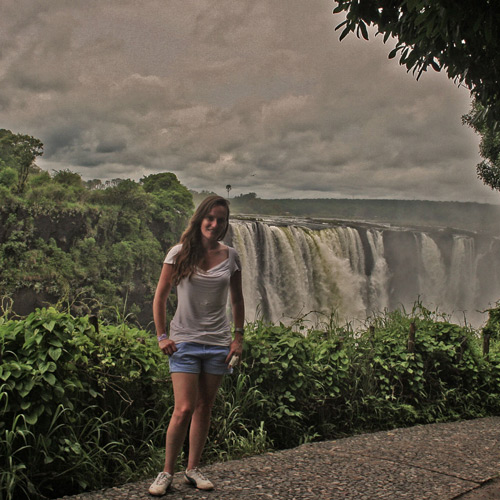 JANINE AVERY is the first to confess that she has been bitten by the travel bug… badly. She is a lover of all things travel, from basic tenting with creepy crawlies to lazing in luxury lodges – she will give it all a go.
JANINE AVERY is the first to confess that she has been bitten by the travel bug… badly. She is a lover of all things travel, from basic tenting with creepy crawlies to lazing in luxury lodges – she will give it all a go.
Janine is passionate about wildlife and conservation, and she comes from a long line of biologists, researchers and botanists.
To comment on this story: Login (or sign up) to our app here - it's a troll-free safe place 🙂.![]()




